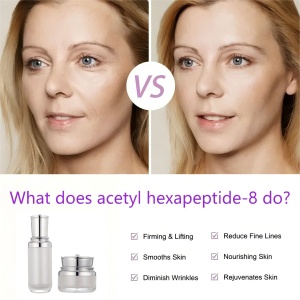What does acetyl hexapeptide-8 do?

Acetyl hexapeptide-8 is a popular ingredient in many anti-aging skincare products, especially those that promise to reduce fine lines and smooth out facial wrinkles. Known as a peptide that mimics the effects of Botox without injections, it’s often marketed as a safe and non-invasive solution for aging skin. But what exactly does it do? This article breaks down how it works, why it’s effective, and where you’re likely to find it in your daily skincare routine.
What Is Acetyl Hexapeptide-8?
Acetyl hexapeptide-8, also commonly called Argireline, is a synthetic peptide made from a chain of six amino acids. It was developed to target the same facial muscle contractions that cause expression lines—especially around the eyes, forehead, and mouth. By relaxing these muscles slightly, the skin above them appears smoother and less creased.
How It Works on the Skin
This ingredient works by interfering with a specific protein complex involved in muscle movement. When applied topically, acetyl hexapeptide-8 inhibits the release of neurotransmitters that cause facial muscles to contract. The result is a reduction in the depth and appearance of wrinkles, particularly those formed by repeated expressions like frowning or smiling.
Main Benefits of Acetyl Hexapeptide-8
The most talked-about benefit of acetyl hexapeptide-8 is its ability to reduce wrinkles without the need for injections. Many people use it as an alternative to Botox, especially those looking for more affordable or less invasive options. Here are some of its main benefits:
- Reduces the depth of fine lines, especially around the eyes and forehead
- Improves skin texture and smoothness over time
- Can be used with other active ingredients like hyaluronic acid and vitamin C
- Works well for people with early signs of aging
Where You’ll Find It
You’ll often find acetyl hexapeptide-8 in serums, moisturizers, eye creams, and even sheet masks. It’s a favorite among anti-aging formulas because it plays well with other ingredients and doesn’t typically cause irritation. Many brands use it in products targeted for people in their 30s and up who are concerned about expression lines and wrinkle prevention.
Who Should Use It?
Most people with mild to moderate signs of aging can benefit from using acetyl hexapeptide-8. It’s gentle enough for daily use and works best when used consistently. However, it's not a replacement for more intense cosmetic procedures if someone has deep, set-in wrinkles. Think of it as a preventative or mild corrective step in your skincare routine.
Any Side Effects?
Acetyl hexapeptide-8 is generally considered safe for most skin types. Since it’s applied topically, the risk of serious side effects is very low. Some users may experience mild irritation, especially if they have sensitive skin or use too many active ingredients at once. Doing a patch test before regular use is always a good idea.
How to Incorporate It Into Your Routine
To get the best results, apply products containing acetyl hexapeptide-8 after cleansing and before moisturizing. Using it twice a day can help improve skin smoothness over time. You don’t need a large amount—a few drops of a serum or a small amount of cream is enough for targeted areas.
Final Thoughts
Acetyl hexapeptide-8 isn’t a miracle cure, but it’s a solid choice for anyone looking to delay the signs of aging without needles or downtime. It helps soften expression lines, adds a smoother look to the skin, and fits easily into most skincare routines. If you're not ready for cosmetic procedures but want visible results, this ingredient might be worth trying.


